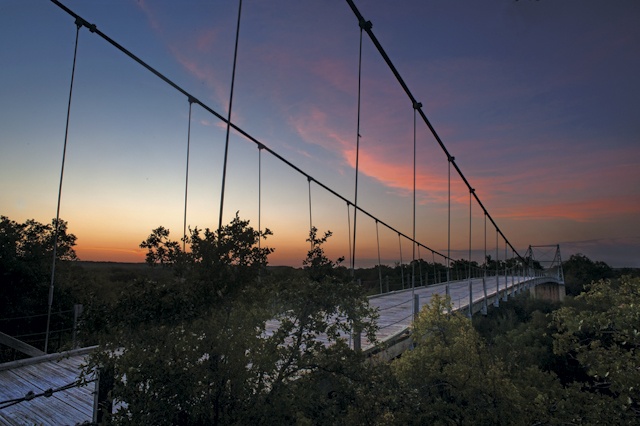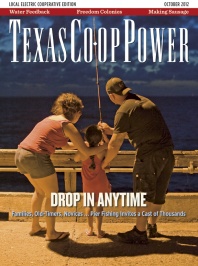The pecan is the official tree of Texas, and pecans are the state’s official nut.
Nutty for the nuts, naturally I headed for the heart of Texas’ pecan country: San Saba, a picturesque Hill Country burg and self-proclaimed Pecan Capital of the World. I not only satisfied my craving but found that San Saba County boasts much more than pecans, with its beautiful green spaces, a resurging downtown San Saba, rare suspension bridges and jewel of a state park: Colorado Bend.
My first stop was Millican Pecan Co., owned by descendants of E.E. Risien. Risien, a cabinetmaker and native of England, got into the pecan-growing business in the 1880s after he identified that the tastiest pecans came from what is known as the “mother pecan tree,” the original tree that Risien cultivated to produce the most flavorful varieties, including the original San Saba Pecan. “He took this one tree and developed new varieties off of it, including the Western Pecan, which is the most populated pecan there is,” said Winston Millican, Risien’s great-great grandson.
I visited the tree, estimated to be hundreds of years old, in a verdant grove along the San Saba River, though it wasn’t as impressive as one might imagine. It had been struck by lightning in recent years and harmed by the way people once harvested pecans by cutting limbs, Millican said. Now, machines shake trees to drop nuts into harvesting machinery.
“I want to be the Johnny Appleseed of pecans. That’s my goal,” Winston said. From the looks of it, he may have competition—Winston, that is. Pecan orchards, processing outfits and specialty stores seem to be around every corner, including Oliver Pecan Co., Alamo Pecan and Coffee Co., Great San Saba River Pecan Co. and San Saba Pecan, which processes more than 30 million pecans a year.
San Saba is undergoing a resurgence of sorts, with the recent unveiling of River Nature Park and Wedding Oak Winery, which recently opened a wine-tasting room in a restored commercial building. The winery is named after another of the city’s famous trees—a massive live oak that stretches across China Creek Road. It got its name because couples frequently got hitched under its impressive branches.
While you’re downtown, visit Harry’s, a well-known cowboy boot and hat shop that has become so successful it has sprawled into adjacent restored buildings and expanded into women’s apparel.
I coaxed a ticket to the exclusive Catkins Ball, which is held each spring at Risien Park and draws hundreds of San Saba movers and shakers dressed in their fanciest duds to raise money for charity. (Don’t know what catkins are? They are the green stringy buds that pecan trees drop seemingly by the ton each spring.)
Among the items auctioned at what local teenagers have dubbed the “grown-ups’ prom”: a 1-year-old dun quarter horse from a local stable and a cruise along the Gulf Coast on a boat owned by Hollywood star Tommy Lee Jones, the town’s most famous product.
Jones is well known for protecting his privacy, but you can pass his ranch southeast of town—look for his polo fields—on the way to Colorado Bend State Park, an outdoor paradise along bluffs and a sharp turn of the Colorado River, where the waterway runs free of dams. Don’t miss the thunderous 60-foot Gorman Falls, accessible by hiking a path that’s lined with wildflowers in the spring.
And, for my money, no trip to San Saba is complete without crossing the old-fashioned wooden bridges: Regency Bridge, a one-lane suspension bridge that spans the Colorado River on the border of San Saba and Mills counties, and the Beveridge, a pedestrian bridge over the San Saba River. When I visited, a few visitors and I jumped on the Regency and felt the bridge gently sway in response.
——————–
Charles Boisseau, frequent contributor


